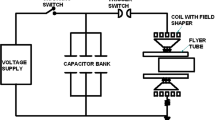Abstract
The MPW (Magnetic pulse welding) process is governed by the electromagnetic force that results from electromagnetic interaction produced by a coil. To produce high electromagnetic force, the MPW process needs to charge high electrical energy through capacitors. The total capacitance and system inductance has an effect on the discharge time, and discharge time also has an effect on the joint. Therefore, the objective of this research is to analyze the effect of the discharge time on the joint and to quantify it using the FE-model. To achieve this, MPW has been performed using Al1070tube and S45Crod. After the experiment, the interfaces of the joint with variations of discharge time were observed utilizing a scanning electron microscope. In addition, a two dimensional electromagnetic-mechanical coupled FE-model has been developed for quantification. Experimental results demonstrated the impact of welded interfaces that have various lengths and amplitudes. It was confirmed from the numerical works that the creation of a wavy form is derived from the change of electromagnetic force according to the variation of discharge time. As the discharge time decreased, the lengths and amplitudes of the wave form decreased through the reduction of the generated electromagnetic force.
Similar content being viewed by others
References
J. Y. Shim, I. S. Kim, M. J. Kang, I. J. Kim, K. J. Lee and B. Y. Kang, Joining of aluminum to steel pipe by magnetic pulse welding, Materials Transactions, 52 (5) (2011) 999–1002.
Y. B. Park, Design of joints for the automotive spaceframe with electromagnetic forming and adhesive bonding, The Degree of Doctor of Philosophy, Graduate School of the Seoul National University (2004) 24–78.
A. Kochan, Magnetic pulse welding shows potential for automotive applications, Assembly Automation, 20 (2) (2000) 129–132.
R. M. Miranda, B. Tomás, T. G. Santos and N. Fernandes, Magnetic pulse welding on the cutting edge of industrial applications, Soldag. Insp. São Paulo, 19 (1) (2014) 69–81.
H. Hokari, T. Sato, K. Kawauchi and A. Muto, Magnetic impulse welding of aluminum tube and copper tube with various core materials, Welding International, 12 (8) (1998) 619–626.
D. Dudko, V. Chudakov, L. Kistersky and T. Barber, Magnetic pulse welding of tubing: Exploring the cold welding process, The Fabricator, 26 (8) (1996) 62–65.
Y. Zhang, S. S. Babu, C. Prothe, M. Blakely, J. Kwasegroch, M. LaHa and G. S. Daehn, Application of high velocity impact welding at varied different length scales, Journal of Materials Processing Technology, 211 (2011) 944–952.
A. Kapil and A. Sharma, Coupled electromagnetic-structural simulation of magnetic pulse welding, Proceeding of AIMTDR 2014, India (2014) 249.1-249.6.
R. N. Raoelison, N. Buiron, M. Rachik, D. Haye and G. Franz, Efficient welding conditions in magnetic pulse welding process, Journal of Manufacturing Processes, 14 (3) (2012) 372–377.
J. Bellmann, J. Lueg-Althoff, G. Goevel, S. Gies, E. Beyer and A. E. Tekkaya, Effect of surface coating on the joint formation during magnetic pulse welding in tube to cylinder configuration, Proceeding of ICHSF2014, Korea (2014) 275–287.
J. Cui, G. Sun, J. Xu, Z. Xu and X. Huang, A study on the critical wall thickness of the inner tube for magnetic pulse welding of tubular Al-Fe parts, Journal of Materials Processing Technology, 227 (2016) 138–146.
J. Lueg-Althoff, B. Schiling, J. Bellmann, S. Gies, S. Schulze, A. E. Tekkaya and E. Beyer, Influence of the wall thicknesses on the joint quality during magnetic pulse welding in tube-to -tube configuration, Proceeding of ICHSF2016, Germany (2016) 259–268.
A. Ben-Artzy, A. Stern, N. Frage and V. Shribman, Interface phenomena in aluminum magnesium magnetic pulse welding, Journal of Science and Technology of Welding and Joining, 13 (4) (2008) 402–408.
A. Ben-Artzy, A. Stern, N. Frage, V. Shribman and O. Sadot, Wave formation mechanism in MPW, International Journal of Impact Engineering, 37 (4) (2010) 397–404.
S. D. Kore, P. P. Date and S.V. Kulkarni, Effect of process parameters on electromagnetic impact welding of aluminum sheets, Journal of Impact Engineering, 34 (2007) 1327–1341.
H. Geng, J. Cui, G. Sun and G. Li, A study on the critical thickness of the inner tube for MPW, Proceeding of ICHSF2014, Korea (2014) 321–330.
V. Shribman and M. Blakely, Benefits of the magnetic pulse process for welding dissimilar metals, Welding Journal, 87 (9) (2008) 56–59.
P. Zhang, Joining enabled by high velocity deformation, The Degree Doctor of Philosophy, Graduate School of the Ohio State University (2003) 183–200.
H. G. Powers, Bonding of aluminum by the capacitor discharge magnetic forming processes, Welding Journal, 46 (1967) 507–510.
J. Y. Shim, I. S. Kim, K. J. Lee and B. Y. Kang, Experimental and numerical analysis on aluminum/steel pipe using magnetic pulse welding, Met. Mater. Int., 17 (6) (2011) 957–961.
ANSYS, ANSYS reference manual-Release5.7, ANSYS, USA (1999).
J. O. Hallquist, LS-DYNA Theoretical Manual, Livermore Software Technology Corporation, Livermore, USA (1991).
Author information
Authors and Affiliations
Corresponding authors
Additional information
Recommended by Associate Editor Hak-Sung Kim
Ji-Yeon Shim earned her master’s degree from the Mokpo National University, Korea. Her research interests are magnetic pulse welding simulation and optimization.
Bong-Yong Kang earned his doctor’s degree from Inha University, Korea. His research focuses on the magnetic pulse welding and forming process of lightweight materials component.
Ill-Soo Kim earned his doctor’s degree from University of Wollongong, Australia. His research focuses on the magnetic pulse welding process of lightweight materials component.
Rights and permissions
About this article
Cite this article
Shim, JY., Kang, BY. & Kim, IS. Characteristics of Al/steel magnetic pulse tubular joint according to discharging time. J Mech Sci Technol 31, 3793–3801 (2017). https://doi.org/10.1007/s12206-017-0723-y
Received:
Revised:
Accepted:
Published:
Issue Date:
DOI: https://doi.org/10.1007/s12206-017-0723-y




